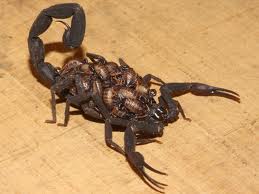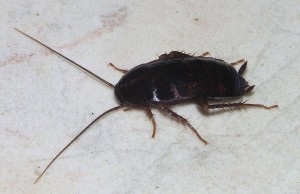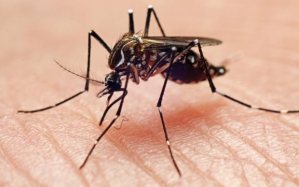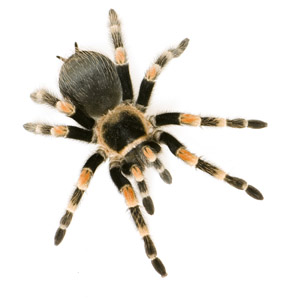Scorpions
 There’s something about that viciously efficient combination of grasping pincers and curved sting that sparks terror in the human brain. But as long as you apply a smidgen of common sense, the chances of getting fatally stung by a scorpion in Southern Africa are in fact very low.
There’s something about that viciously efficient combination of grasping pincers and curved sting that sparks terror in the human brain. But as long as you apply a smidgen of common sense, the chances of getting fatally stung by a scorpion in Southern Africa are in fact very low.
South Africa has quite a few scorpion species, but luckily for those of us who like the bundu and can’t resist turning over rocks, not many of our scorpions are highly venomous, and the risk of a fatal sting is slim. In the great majority of cases, stings cause pain that lasts no more than a few hours, with no further symptoms. The annual death rate from stings is only about one to four.
The sting’s the thing
Scorpions with broad pincers often look fearsome, but the pincers are just for grabbing; the sting’s in the tail. There’s a general rule of thumb to distinguish highly venomous scorpions from the mildly venomous (i.e. harmless to humans):
- Highly venomous: thick tails, thin pincers
- Mildly venomous: thin tails, thick pincers
This rule applies to scorpions throughout the world.
In South Africa, it’s almost always scorpions belonging to the genus Parabuthus that cause fatalities. These scorpions typically inhabit dry areas, and like digging burrows in sandy soil, sometimes under rocks or at the base of vegetation.
How to avoid being stung
First, do a bit of research on the area you’re going to, and find out if scorpions are endemic there. If they are, it’s even more important than usual to follow these precautions:
- Wear shoes, particularly covered shoes and particularly at night. Most stings happen at night, to people going unshod.
- Take care when lifting up rocks and fallen branches. It’s a good idea to wear sturdy gloves when doing camping chores like building a fire, moving rocks to put up a tent etc.
- Scorpions and other fearsome beasts are a good motivation to set up and pack up camp while there’s daylight.
- Shake out bedding before you get into it and when packing up. Do the same with clothes and shoes before dressing.
- Don’t sleep directly on the ground – use a groundsheet at least. Your sleepingbag and tent also afford protection, but keep them zipped up.
- Avoid sleeping right next to where scorpions may be hanging out, like at the base of thick vegetation.
Keep in mind that most stings occur in the period from October to March, with January-February, i.e. summer, as the peak.
What happens if you get stung
If a scorpion stings you, you’ll usually know about it. Even if you don’t actually see the culprit, you’ll feel the result: a sudden, often burning pain at the sting site. The pain may persist from a few minutes to a few hours, and there may be redness and swelling at the sting site. Fewer than 5% of stings result in symptoms requiring medical attention. Such symptoms, which suggest a serious sting, generally only start to occur after about half an hour, and sometimes only after several hours. These may include any of the following:
- Abdominal cramps
- A burning sensation, or pins-and-needles, usually of the hands, feet, face and scalp.
- Hypersensitivity to tactile stimuli e.g. your clothing or bedding become irritating to your skin. Sometimes you also become extremely sensitive to noise.
- Lack of co-ordination with stiff-legged or ‘drunken’ walking.
- Involuntary movements, tremors, muscle weakness
- High or low pulse rate
- Difficulty swallowing and excessive salivation i.e. drooling
- Difficulty speaking normally
- Excessive sweating
- Headache, nausea, vomiting, diarrhea
- Droopy eyelids
- Restlessness and anxiety
- Urine retention
- Difficulty breathing.
The severity of the sting will depend on several different factors: the species of scorpion, its size and level of agitation, and where it stings you. A bigger scorpion packs a bigger venom punch, as does a deeper sting.
Your health and age are also significant; stings are more dangerous for children and the elderly, and someone with cardiac or respiratory problems is at higher risk of a serious reaction.
What do to if you get stung
This is one time when you’ll be forgiven for killing wildlife*: it’s useful to keep the scorpion for identification purposes. But only try to bag the specimen if you can do so without risking another sting! Unless you’re an expert (i.e. you’ve done it many times before) don’t attempt taking the prisoner alive.
Clean the wound and apply a clean cloth, wrapped in ice or moistened with cold water, to the sting site. Take an over-the-counter painkiller like aspirin or paracetamol. If possible, get to the nearest hospital or doctor. Take note of any changes or additional symptoms that may occur.
No-one, except a medical professional trained to treat scorpion stings, should attempt to use any additional methods of treatment. Using the wrong kind or amount of anti-venom or other medications can be very dangerous.
It’s also important to reassure the scorpion’s victim that death from a sting is most unlikely. Sometimes people get into such a panic that they can even start to show false symptoms!
*You’re only forgiven if it’s actually stung someone; otherwise you get an indelible black mark on your Green record.
Olivia Rose-Innes
References
Leeming, J. 2003. Scorpions of South Africa. Struik Publishers, Cape Town.
Shire, L., Muller, G.J. and Pantanowitz, L. 1996. The diagnosis and treatment of envenomation in South Africa. Journal of the South Africa Institute for Medical Research.
NYC cockroach can survive frigid winters
A species of cockroach native to Asia that has been seen crawling around an outdoor tourist destination in New York City can survive the city’s often brutal winters, according to a new study.
Researchers at Rutgers University in New Jersey have identified the resilient pest as Periplaneta japonica, which is native to Japan. Until an exterminator saw the bug last year crawling around the High Line, an elevated, outdoor park in lower Manhattan, it had not been confirmed in the United States.
While it was too soon to predict the implications for nearby residents and businesses, the bug’s appearance could be good news, researchers said.
“[Cockroaches] combined numbers inside buildings could actually fall because [the] more time and energy they spent competing [for food and space] means less time and energy to devote to reproduction,” said Rutgers biologist Dominic Evangelista, who helped identify the species by analysing its DNA barcode.
How the bugs got to New York was unclear, but researchers speculated they were in the soil of one of the plants festooning the park.
Researchers noted the new roach cannot breed a hybrid super-roach by mating with the more common local variety due to mismatching genitalia.
Why mosquitoes bite us
Researchers have learned more about how mosquitoes detect skin odour, and they say their findings could lead to better repellents and traps.
Mosquitoes are attracted to our skin odour and to the carbon dioxide we exhale. Previous research found that mosquitoes have special neurons that enable them to detect carbon dioxide. Until now, however, scientists had not pinpointed the neurons that mosquitoes use to detect skin odour.
Pleasant odours
The new study found that the neurons used to detect carbon dioxide are also used to identify skin odour. This means it should be easier to find ways to block mosquitoes’ ability to zero in on people, according to the study’s authors. The findings appeared in the journal Cell.
“These findings open up very realistic possibilities of developing ways to use simple, natural, affordable and pleasant odours to prevent mosquitoes from finding humans,” senior author Anandasankar Ray, of the University of California, Riverside, said in a journal news release.
Dangerous diseases
Mosquitoes can carry dangerous diseases such as malaria, dengue fever and West Nile virus.
“The powerful experimental approaches we have developed will help us find potential solutions that we could use not only here in the United States but also in Africa, Asia and South America, where affordability is key in the war against these diseases,” Ray said.
“The insect olfactory system is an excellent target to manipulate their attraction to humans and other prey,” Ray said. “We believe that this study will be the foundation for the discovery of a new generation of mosquito-behaviour-modifying approaches.”
More information
The US Centres for Disease Control and Prevention has more about mosquito-borne diseases and the mosquito menace.
Spiders and spider bites
South Africa has an impressive 2000 identified spiders, and in the warmer summer months, chances are good that you will encounter some of them. We all know that spiders are our friends – they eat flies and mosquitoes and other bugs that we do not particularly like. But unfortunately, some of these spiders leave a bite that is not as friendly.
Know Our Spiders
Knowledge is the key to protect your loved ones from potentially venomous spiders – you need to know your local spiders, how to prevent bites and what to do when a bite does happen. Spider bites can be nasty, but rarely kill. But with all venomous encounters, some people are more at risk for complications: The elderly, children, immune system-compromised and allergic people.
Dangerous Spiders of South Africa
• Black Widow/Button Spider: This is probably the most well-known South African spider, identified by the red hourglass on its round, black abdomen. Button spiders are found all over South Africa, and they usually reside in quiet, dark places. They rarely wander into houses, and most bites occur when the spider are disturbed in its hiding place. Button spiders have neurotoxic venom, which means that it attacks the central nervous system. Only female spiders have fangs large enough to pierce human skin. Bites are very painful and symptoms will appear shortly after the bite: Sweating, raised blood pressure, muscle pain and cramps, pain and weakness in the limbs, the face becomes contorted, flushed and sweaty with drooping eyelids and swollen lips. In severe cases the body will contort and shake uncontrollably. Button spider bites are usually treated in hospital with anti-venom and patients are usually well enough to go home after 24-48 hours. The good news is that no deaths from button spiders have been recorded in the last 50 years.
• Violin Spiders: Violin spiders are found all over South Africa. They are normally brownish with dark markings on their bodies, as well as a characteristic violin-shape on the front part. Bites are rare, and usually happen at night when the victim is sleeping. They have cytotoxic venom, which means that it destroys tissue. Bites are small and painless, but after a few hours the site swells up and becomes discoloured, which is followed by blistering and peeling of the skin – leaving an open wound. Untreated bites can lead to infections, septicaemia and necrosis – and usually surgery is needed to remove the dead tissue. No anti-venom is available for violin spider bites, and treatment is to prevent infection and promote healing.
• Sac Spiders: Sac spiders are yellowish with a black head. It is an aggressive spider and is responsible for most spider bites in South Africa. They are notorious for the nasty bite they give, and most bites occur during the night when an unsuspecting victim rolls over on a roaming spider. Sac spiders have cytotoxic venom – the bite is painless and looks like a mosquito bite. After a few days it is swollen and painful and eventually forms a large lesion. No anti-venom is available, but antibiotics are needed to treat the lesion and prevent infection and tissue damage. The wound can take up to four weeks to heal, but in severe cases it can take up to a decade for the area to recover. Hospitalisation is not necessary, but plastic surgery is sometimes needed to remove damaged tissue.
• Baboon Spider: Baboon spiders are generally not venemous, even though they can inflict a very painful bite. However, there are one species of baboon spider found in the Western Cape, Harpactira lightfooti, which has neurotoxic venom (similar to the black widow), causing severe symptoms such as pain, shock, vomiting, paleness and difficulty walking. They are frequently found in houses, but bites are fortunately very rare.
• Six-Eyes Sand Spider: These spiders are rare – they are found in desert areas and basically looks like a crab with sand stuck to its body. No human bites have been documented, but studies on rabbits have proven that these spiders might be lethal to humans, their bites causing massive tissue destruction and internal haemorrhaging.
Precautions:
• Keep your backyard clean from rubble – spiders love to hide in rubble.
• Inspect the underside of windowsills often – button spiders are notorious for hiding there.
• If you regularly find spiders in your house, check your children’s beds before you tuck them in.
• Clear clutter from the floor – encourage your children to throw clothes in the laundry basket and pick their toys up.
• Regularly inspect curtains and night frills for sac spiders – they are usually found in a silky sac in the pleats.
• Check behind picture frames and dust regularly.
• Check shoes before putting them on. It is surprising how many people get bitten on their feet.
• Try not to leave clothes on the washing line overnight, and if you do, check them thoroughly before putting them away.
• If you have a serious spider problem, consider spraying a thick layer of Baygon Green on the inside of windows and door frames every 4 weeks. Unfortunately it will kill the spider, so please only do this in extreme cases!
When Someone Is Bitten
• Keep calm. A spider bite does not mean instant death – in most cases you only need a painkiller, antihistamine and wound management. For button spiders, however, the patient should be taken to hospital immediately. Also, children should be checked out by a doctor as soon as possible after a bite.
• Try to catch the spider – this makes identification and treatment much easier.
• Wash the bite site with soap and water. Apply an ice pack.
• Wounds should be kept clean, and antiseptic cream applied regularly.
• All spider bite victims must go for a booster tetanus injection.
• If more severe symptoms appear, see a doctor immediately.
By Leanda C. Retief



